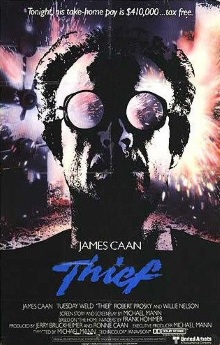
Drive was one of the most distinctive films of 2011 so when I learned that it borrowed liberally from this 1981 movie, that definitely put it on my radar. It also helps that I consider Heat , probably the film for which Michael Mann is most famous, to contain some of the best gunplay scenes ever captured on film. So right from the opening shot with the camera ever so slowly panning down a tenement block to the rain-slicked street at night, I felt right at home.
Whatever one thinks about other aspects of this film, there can be no denying that it is visually striking. It’s the work of a director who understands that the photography is the art of understanding the relationship between light and darkness and is a master at molding light to his will. It is also the work of a confident director, someone who is content to let the camera linger on a scene for long moments to achieve maximum impact or to include a scene just because it is beautiful. The early dawn scene in which James Caan’s Frank quietly contemplates the luminous sea together with a fisherman is a great example. It says something of Frank’s character that he would choose to unwind after a heist like this, but the scene itself is so unique that no other reason is needed to justify its inclusion.
The plot would be completely conventional if not for how interesting the characters are. Frank is the consummate professional thief who eschews violence and expresses pride in his work. Past the prime of his life, he searches for the ultimate score that will allow him to retire and settle down with the woman of his choice. James Caan calls the diner scene in which he lays down his cards to Tuesday Weld’s Jessie the best scene of his career. Indeed it has to be one of the most original courtships seen on film. I also liked how Robert Prosky’s Leo thoroughly demonstrates the foolishness of owing favors to the mob and James Belushi’s supporting role as Frank’s partner. Apparently this was Belushi’s feature film debut and I was struck by how much he resembled a paunchy Jeremy Renner.
But the real draw about this film remains how its visuals and sound combine to create a mesmerizing spectacle. The electronic music group Tangerine Dream created the unique soundtrack for this movie and apparently it impressed so many people it became the first of many compositions they made for the film industry. The music, which usually plays only in the night scenes, adds a palpable sense of menace to the streets and urgency to the actions of the protagonists. Together with the film’s obsession with capturing reflections on all manner of surfaces and neon lights glaring out of the dark, down to exercising precise control over what color a car’s tail lights should look like, the futuristic sounding music gives the movie almost a cyberpunk feeling.
This attention to visual detail also shows up in the scenes in which Frank breaks into vaults. Mann delights in showing the audience every step of the intricately technical process, almost as if he were a filming a step-by-step guide to safecracking for YouTube. There is something primordially powerful about watching Frank apply pure, inexorable brute force to open the safes, so different from the fancy gadgets and clever finesse of modern heist scenes such as those found in the rebooted Mission Impossible movies. Wielding a thermal lance to pierce a vault may not make their plan all that more plausible, after all how could they possibly transport all that equipment and how can they expect all the noise to be unnoticed, but all those angry red sparks and molten metal sure make for memorable imagery.
Comparing Thief to Drive, I find that I still prefer the more modern film. For all that I respect Thief for being first, I think Drive better integrates its stylistic touches with its plot and the nature of its protagonist. But this remains a fantastic film that is well worth watching and seems to be sadly underappreciated.